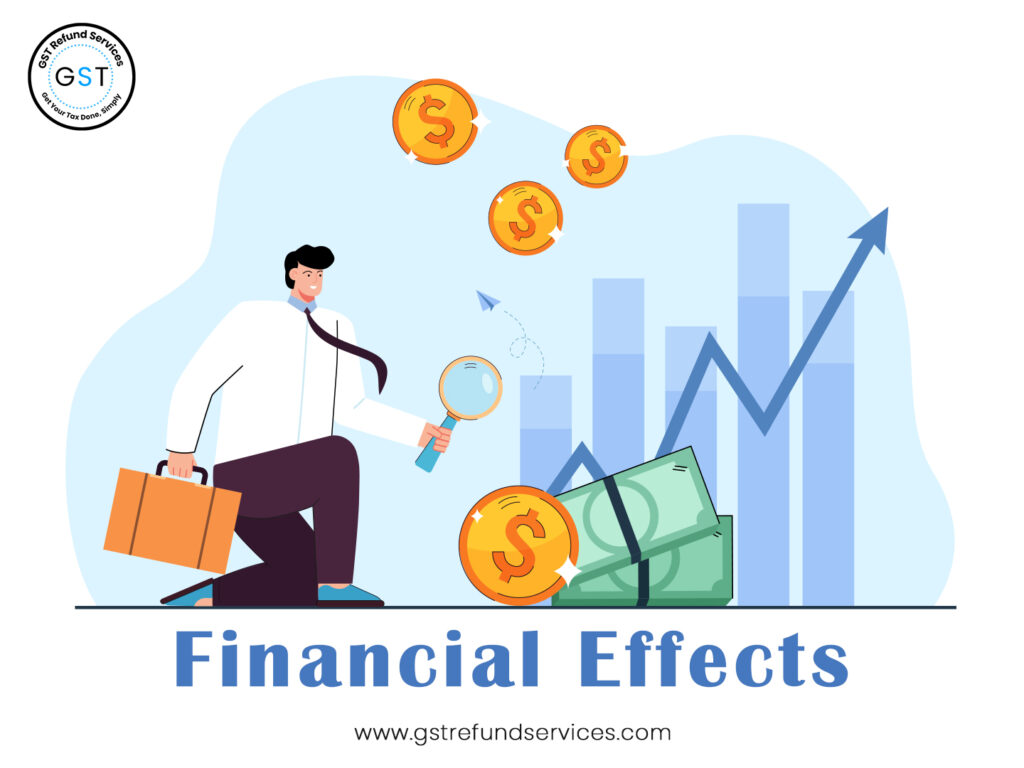The implementation of the Goods and Services Tax (GST) has unquestionably had a variety of effects on economies, businesses, and consumers. Let’s now examine the intricate impact of GST on a number of dimensions:
- Economic Impact:
- Simplifying the Tax System: By replacing many indirect levies with a single tax, the Goods and Services Tax (GST) simplifies and explains the tax system.
- Expanded Tax Base: By bringing previously uncontrolled enterprises into the tax system, the GST has increased the tax base and increased government revenue.
- GDP Boost: The efficiency and transparency brought about by the GST might positively impact GDP growth by reducing tax evasion and increasing overall economic productivity.
- Business Impact:
- Supply Chain Efficiency: Overall production costs have decreased and supply chain efficiency has enhanced since the GST eliminated the cascading effect of taxes.
- Improved Compliance: A unified tax system saves businesses operating costs by simplifying tax compliance.
- Technology Adoption: The introduction of the Impact of GST Goods and Services Tax has prompted a technology revolution in business operations by requiring the use of digital technologies for reporting and compliance.
- Customer Impact:
- Price Variations: Price changes for goods and services could be impacted by changes to the tax code. Prices for some goods might go up, while prices for others might go down.
- Improved Services: Customers may expect improved services as a result of a more open and efficient tax system as businesses streamline their operations and pass along the benefits of lower taxes to their clients.
- Shifts in Customer Behavior: Price and service availability changes may have an effect on customer behavior, which may result in changes to purchasing patterns.
- Challenges and Concerns:
- First-time disruptions: The switch to the GST usually results in some early disruptions while companies get used to the new tax structure.
- Compliance Challenges: Small businesses, in particular, may find it challenging to adapt to the new compliance requirements, which could lead to issues.
- Administrative Difficulties: Effective administration and execution of the Goods and Services Tax (GST) require strong administrative and technological capabilities, which may provide challenges for certain economies.
- Global Competitiveness:
- Competitive Advantage: By improving the economic climate and drawing in both domestic and foreign investors, a well-executed GST system can make a nation more competitive.
- Trade Facilitation: By lowering obstacles and strengthening economic integration, GST can promote easier cross-border trade through streamlined tax procedures.
6.1 Financial Impact Of GST

6.1.1 Growing The GDP
One of the main economic Impact Of GST is its ability to gradually raise GDP. The cascading effect of taxes on the production and distribution of goods and services has been eliminated with the implementation of the Goods and Services Tax (GST), which replaces many indirect taxes with a single, unified tax system. Overall economic production increases as a result, and tax collection becomes more efficient.
GST can stimulate investment, output, and consumption by lowering the cost of compliance, streamlining tax procedures, and fostering an environment that is more business-friendly. Higher GDP growth rates are the result of increased economic activity, which is advantageous for the economy as a whole.
6.1.2 Reducing Tax Evasion
The transparency and self-policing elements of the GST have significantly reduced tax evasion. The digital trail of transactions and the smooth flow of input tax credits (ITC) allow tax authorities to promptly monitor tax payments and guarantee compliance.
Furthermore, the establishment of a strong GST network that provides real-time data and invoice matching makes it easier to spot discrepancies and motivates companies to accurately report their activities. As a result, there has been a decline in tax evasion, raising tax revenues that may be used to fund infrastructure and public services.
6.2 Business Perspective

6.2.1 Supply Chain Simplification
Businesses now handle their supply chains differently as a result of the GST. Businesses usually experienced delays and inefficiencies managing a convoluted web of federal, state, and local taxes prior to the implementation of the GST. These obstacles no longer exist because of the Impact Of GST, which makes it simple to sell goods and services across state lines.
Supply chain simplification has improved logistics and distribution efficiency by cutting costs and transit times. Companies can cut costs and speed up delivery times by optimizing their distribution and warehousing systems.
6.2.2 Impact On Prices And Profitability
Depending on the product and industry, Impact Of GST has varying effects on price and profitability. Certain commodities may have cost more due to higher tax rates, while other things may have cost less due to reduced rates or input tax credits.
Businesses that use their ITC benefits frequently have lower tax obligations, which can result in higher profit margins. Nonetheless, companies need to make sure that they pass along the advantages of reduced tax obligations to their clients in order to avoid penalties.
By managing their prices well, businesses can get a competitive edge in the market. Pricing strategies have to be adjusted in light of the new GST regime.
6.3 Consumers’ Point Of View about Impact Of GST

6.3.1 Changes In Consumer Behaviors
The Impact Of GST on consumer behavior and purchasing patterns is evident. Consumers are better able to understand the tax components of product and service costs thanks to the tax system’s transparency. Customers may now make more informed decisions about what to buy because of this awareness.
Consumers might be more inclined to choose products and services with reduced tax rates, which might affect the market demand for particular products and services. Furthermore, input tax credits may be able to lower the overall tax burden on customers.
6.3.2 Impact On Prices And Inflation
It’s complicated to predict how the GST would affect inflation and price increases. Higher GST rates have resulted in price decreases for some goods and services and price hikes for others. The net impact on inflation is influenced by a number of variables, such as market dynamics, demand elasticity, and particular tax rates.
Prices may change briefly while businesses file claims for input tax credits and make adjustments to the new tax structure. Over an extended period, the overall effect on inflation is anticipated to be neutral or slightly deflationary, as the elimination of cascading taxes and enhanced supply chain effectiveness can lower production expenses.
Visit GST Refund Services For More!


